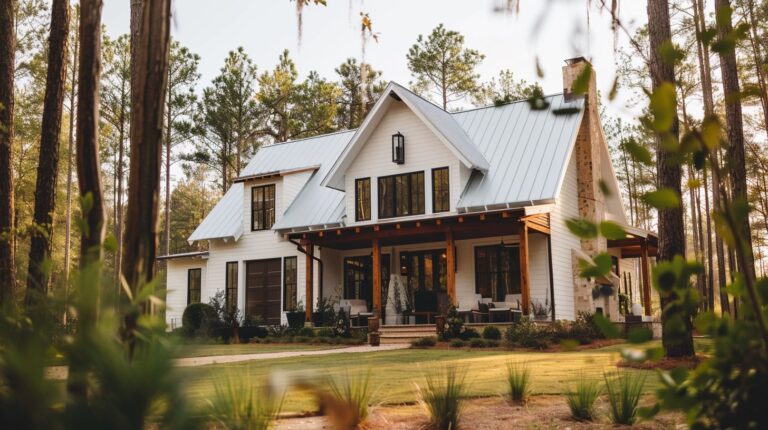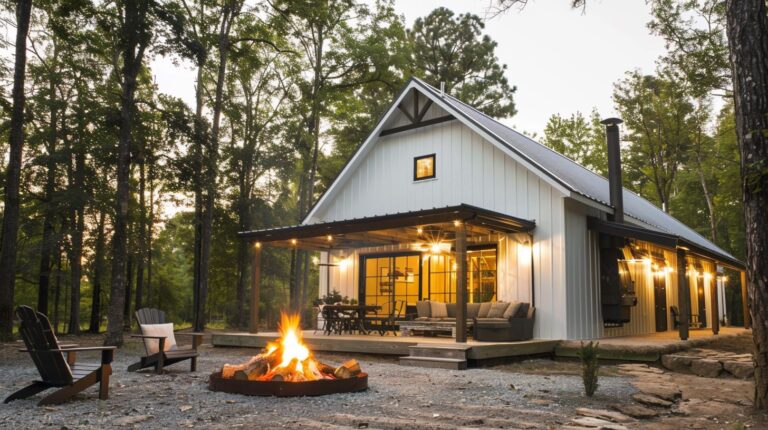How To Get a Mortgage For Your Barndominium | An In-Depth Guide
In recent years, the concept of barndominiums has risen from niche to mainstream, attracting attention for their blend of modern living spaces with the rustic charm of barn-style architecture.
These structures, which often serve dual purposes as homes and workshops or stables, offer a unique alternative to traditional residential housing. However, despite their growing popularity, financing a barndominium can be a complex process.
In this article, we will guide you through the process of financing your barndominium;
| Key Takeaways | Details |
|---|---|
| Challenges of Financing | Barndominiums face unique financing challenges due to their unconventional nature and the difficulty in finding comparable properties for appraisals. |
| Preparation for Financing | Essential steps include improving credit scores, assembling detailed project documentation, and consulting with current barndominium owners for insights. |
| Financing Options | Various options include conventional loans, FHA loans, USDA loans, VA loans, personal loans, and home equity loans, each with their own set of requirements and benefits. |
| Step-by-Step Financing Guide | Steps include estimating the budget, choosing the right loan type, completing the application process, and closing the loan. |
| Construction Loan Process | Involves understanding the loan structure, managing the draw schedule and inspections, and transitioning to a permanent loan upon project completion. |
| Credit Score Requirements | Minimum credit scores vary by loan type, generally ranging from 620 for conventional loans to lower for FHA and USDA loans. |
| Down Payment Considerations | Down payment requirements vary, with some loans like VA and USDA offering no down payment options, while conventional loans may require up to 20%. |
| Navigating Appraisals | The appraisal process can be challenging for barndominiums due to the lack of comps, requiring flexibility and sometimes creative solutions. |
Understanding the Challenges of Barndominium Financing
Navigating the Financing Landscape
Financing a barndominium presents a unique set of challenges, primarily due to the unconventional nature of these properties. One significant hurdle is the scarcity of comparable market properties (comps), which can complicate the appraisal process. Lenders and financial institutions typically rely on comps to assess the value of a property, and the unique features of barndominiums can make it difficult to find similar properties for comparison. This scarcity can lead to hurdles in the appraisal process, as appraisers may need to extend their search beyond the local area or use non-traditional comparables, potentially affecting the loan eligibility and terms.
Moreover, lender hesitation can also pose a challenge. Due to the non-traditional nature of barndominiums, lenders may be less familiar with these types of properties and, therefore, more cautious about approving financing. This section would delve into these challenges, emphasizing the importance of presenting a well-planned project to potential lenders to increase the likelihood of securing financing. It would also discuss strategies for overcoming these hurdles, such as preparing detailed construction plans, securing accurate appraisals, and researching lenders familiar with barndominium financing.
Preparing for Financing
Laying the Groundwork for Your Barndominium Dream
Before embarking on the journey to finance a barndominium, potential owners must engage in meticulous preparation. This preparation is twofold: ensuring personal finances are in order and gathering detailed project information. First and foremost, improving one’s credit score and resolving any outstanding credit issues are crucial steps. A higher credit score not only increases the likelihood of loan approval but may also result in more favorable loan terms.
Simultaneously, assembling a comprehensive package of documentation is essential. This includes finalized blueprints, a detailed budget including both construction and finishing costs, a timeline for project completion, and bids from contractors. Such thorough preparation demonstrates to lenders the viability and thoughtfulness of the project, thereby enhancing the borrower’s credibility.
Engaging with current barndominium owners can provide invaluable insights into the financing process. These individuals can offer advice based on their experiences, including tips on navigating the challenges of loan approval and recommendations for lenders who are open to financing such projects. This preparatory phase is critical in setting a solid foundation for securing financing.
Exploring Financing Options
Navigating Through a Maze of Financial Avenues
Once the groundwork has been laid, it’s time to explore the various financing options available for barndominiums. Understanding the nuances of each loan type can help borrowers select the one that best fits their needs and circumstances.
Conventional Loans
Conventional loans, provided by private lenders, banks, and credit unions, are a common route for financing barndominiums. These loans often require a strong credit score and a significant down payment, usually around 20% of the loan value. However, they come with the benefit of lower interest rates and the flexibility to negotiate terms.
FHA Loans
The Federal Housing Administration backs FHA loans, which are designed to reduce the barriers to homeownership for those with lower credit scores or smaller down payments. For a barndominium, an FHA loan can cover a wide range of costs, including land purchase, construction, and permits, with down payments as low as 3.5%.
USDA Loans
For those looking to build in rural areas, USDA loans offer an attractive option. These loans, guaranteed by the U.S. Department of Agriculture, require no down payment and offer favorable terms. They are designed to encourage rural development and are available to those who meet certain criteria.
I can’t directly access or retrieve real-time web content or updates beyond my last training data in April 2023. However, based on the information and the outline we’ve been working with, I can help draft the next two sections of your article on financing a barndominium:
Step-by-Step Guide to Financing a Barndominium
From Planning to Approval: A Comprehensive Path
- Budget Estimation: The first crucial step in financing a barndominium is to accurately estimate the total cost of the project. This includes the cost of the land (if not already owned), construction materials, labor, permits, and any other expenses that may arise during the building process. A clear and detailed budget helps in determining the amount of financing required and ensures that all aspects of the project are financially accounted for.
- Choosing the Right Loan Type: Based on the estimated budget and personal financial situation, the next step is to select the most suitable loan option. This involves comparing different types of loans, such as conventional, FHA, USDA, and VA loans, and assessing their terms, interest rates, down payment requirements, and eligibility criteria. Potential borrowers should consider their credit score, income level, and the location of the property to identify the loan that offers the most favorable terms for their situation.
- Application Process: Once a loan type is selected, the borrower should prepare and gather all necessary documentation for the application. This includes financial statements, credit reports, proof of income, detailed project plans, and any bids from contractors. Lenders may also require a comprehensive appraisal of the proposed barndominium to assess its value and the feasibility of the project.
- Closing the Loan: After the loan application is approved, the final step is the closing process. This involves reviewing and signing the loan agreement, paying any required down payments and closing costs, and setting up a schedule for loan disbursement. For construction loans, funds are typically released in stages as the project progresses, with each disbursement subject to lender approval based on the completion of predetermined construction milestones.
By following these steps, borrowers can navigate the financing process more smoothly, ensuring that they have the necessary funds to bring their barndominium project to fruition.
Navigating the Construction Loan Process
Managing Funds and Expectations
The construction loan process for a barndominium is unique because it involves financing not just the purchase of property, but also the cost of building. Here are key considerations and steps involved:
- Understanding the Construction Loan Structure: Construction loans are typically short-term loans that cover the cost of building. Once construction is completed, these loans can be converted into a permanent mortgage. Borrowers should understand the terms, interest rates, and conversion process before agreeing to a construction loan.
- Draw Schedule and Inspections: Funds from a construction loan are usually disbursed according to a draw schedule, which outlines specific milestones in the construction process. After each milestone is reached, an inspection is conducted to ensure the project meets the predetermined criteria before the next tranche of funds is released. This process helps manage the budget and ensures that the project stays on track.
- Transitioning to a Permanent Loan: Once construction is complete, the construction loan needs to be converted into a permanent mortgage. This process typically involves a final inspection and appraisal to confirm the value of the completed barndominium. Borrowers may have the option to choose between fixed-rate or adjustable-rate mortgages for their permanent financing, depending on their long-term financial goals and market conditions.
Navigating the construction loan process requires careful planning and coordination with the lender to ensure that funds are available as needed and the project progresses as planned. By understanding the structure of construction loans and the requirements for disbursement and conversion, borrowers can effectively manage their financing and avoid potential pitfalls during the building process.
Securing Your Barndominium Dream: A Journey of Preparation and Persistence
Financing a barndominium is a journey that requires diligent preparation, thorough research, and steadfast persistence. From understanding the unique challenges associated with these distinctive properties to navigating the myriad of financing options, the path to securing funding for a barndominium is complex but navigable. As we’ve explored, preparing a comprehensive project plan, enhancing your financial profile, and carefully selecting the right financing option are crucial steps toward turning your barndominium dream into reality.
This exploration underscores the importance of approaching the financing process with a well-organized strategy. Gathering detailed information, consulting with current barndominium owners, and aligning with lenders who are familiar with or specialize in non-traditional property financing can significantly enhance your chances of approval. Moreover, understanding the nuances of construction loans, from draw schedules to the transition to permanent financing, is essential for effectively managing your project’s financial aspects.
As barndominiums continue to gain popularity, the financing landscape may evolve to accommodate these unique living spaces more readily. Until then, potential builders and homeowners must navigate the existing pathways with knowledge and foresight. By doing so, you can not only secure the necessary financing but also ensure that your barndominium project is built on a solid financial foundation.
Remember, the process of financing a barndominium is as much about patience and perseverance as it is about numbers and contracts. With the right approach and preparation, achieving the dream of owning a barndominium is within reach. As you embark on this journey, let the challenges inspire rather than deter you, knowing that at the end of this path lies a home that is uniquely yours, both in design and spirit.







